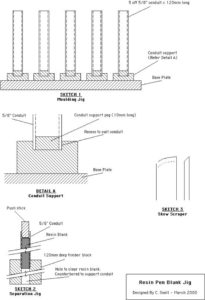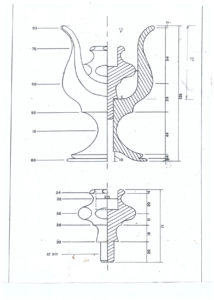By Clarrie Snell
The pens may initially take a while to make, however the finished article is extremely durable with brilliant colours that are striking and pleasing to the eye.
Mixing Equipment
- 4 flexible plastic containers (bottom half of small round drink containers or drink cups).
- 6 Stirrers (old hacksaw blades, or wooden sticks).
- Eye dropper.
- Dessert spoon or measuring cup.
Safety
- Wear eye protection during the mixing procedure. The Resin Hardener, MEKP, is a dangerous substance to handle. Safety goggles should be worn during handling, as loss of eyesight is possible if MEKP comes in contact with the eyes.
- Read safety instructions before using this substance.
- Wear face masks with filters to suit chemicals during the mixing procedure, machining and finishing.
- Wear disposable gloves during mixing procedure.
Chemicals
- Acetone for cleaning purposes.
- Surf Board Resin (Finishing Resin GC3).
- Resin Hardener (MEKP)
- Resin colours to suit your taste.
- Vaseline (petroleum Jelly).
Mould and release equipment
- 5 pieces 5/8 OD electrical conduit x 120mm long.
- Timber moulding jig, to support conduits (see sketch 1).
- Timber separation jig with metal drift (see sketch 2
Preparation
- Place small amount of Vaseline onto moulding jig timber pegs and conduit supports.
- Locate conduits onto timber pegs.
Mixing Procedure
- Place 1 dessertspoon of resin into 3 plastic containers.
- Using 3 separate hacksaw blades, place a small amount of each colour into each of the 3 containers and stir thoroughly.
- Place 9 dessert spoons of resin into the remaining small plastic container .
- With another hacksaw blade, add white colour, slightly more quantity than for the smaller containers and stir thoroughly
- Add 4 drops of MEKP Hardener to each of the 3 colour containers,. Stir thoroughly.
- Add 36 drops of MEKP Hardener to the white colour container and stir thoroughly.
- Pour the contents of the three-colour containers into the white colour container, one at a time, using a circular motion onto the surface of the white resin. DO NOT STIR COLOURS TOGETHER otherwise you will have one solid colour mix and not a colour pattern that you are trying to achieve.
- With a clean hacksaw blade, gently pierce or push the colours into the white colour, just a few times, the more you pierce the more you mix the colours into the white base colour.
- Gently pour mixture into conduits.
- Curing of resin pen blanks may take about 4 hours, depending on temperature. Resin blanks will not stick to the conduits but will shrink away from the sides making it easy to push the blanks out of the conduits.
- After the blanks have cured, support conduit in separation jig. Use a steel drift to remove resin blank from conduit, (sketch 2).
Machining
- Cut resin blanks to 52mm long.
- Set lathe speed to approximately 1200rpm for drilling, turning and finishing operations.
- Place Jacob chuck into headstock and place half resin blank into chuck with about 20mm protruding.
- Drill through with 6.9mm drill, clearing drill regularly to prevent resin blank from overheating. Note 7.0mm drill will drill oversize hole for the pen brass sleeve.
- Repeat above step for other half of resin blank.
- Glue brass sleeves into pen blanks, preferably with a 2 pack epoxy glue.
- After glue has dried, face ends of resin blanks to suit length of pen brass sleeve.
- Place pen blanks onto mandrel.
- Rough turning/shaping may be carried out using a one-sided curved skew scraper, (see sketch 3), or by using 80 grit paper.
- Turn pen to desired shape with pen clip end turned to 8.1 diameter.
Finishing
- Use 240 wet and dry paper with water to remove all marks and imperfections.
- Repeat above step using 400 wet and dry paper and water.
- Finish polish using metal or car polish.
- Repeat above step. The pen should now have a high gloss finish, if not repeat step 3.
- Assemble pen.


